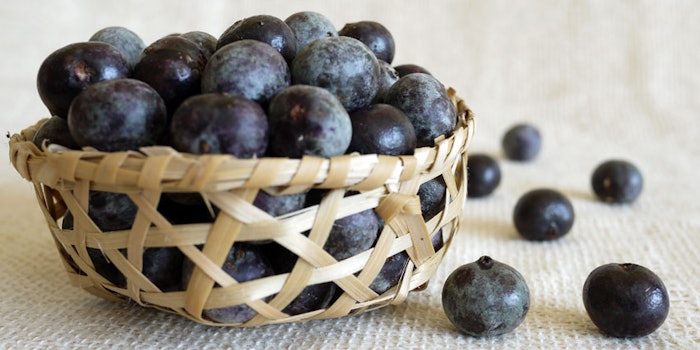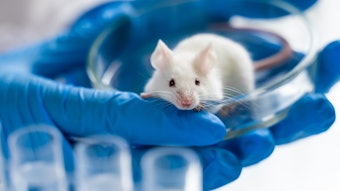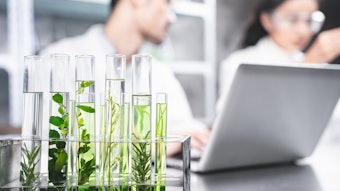
One of the challenges in developing antiaging products is to inhibit the oxidative damages caused by free radicals. Free radicals can damage cellular genetic material, causing changes in the cell’s proliferative and biosynthetic capacity and resulting in aging of the organism.1–3 Free radicals can be inhibited by molecules that present antioxidant activity. These molecules have reducing activity; they are able to donate electrons to the free radical in a way that neutralizes its unpaired electron, eliminating its reactivity.
The development of new cosmetic products presenting antioxidant activity will be essential for the fight against aging. Today, the most frequently used antioxidants are ascorbic acid (vitamin C) and α-tocopherol (vitamin E). However, exploration of Earth’s vegetal biodiversity is uncovering new plant materials. It is of great importance not only to find new materials with anti- oxidant potential but also to use a standard methodology to determine how much potential each of those materials has for use in the fight against aging.
This article discusses one of those methodologies—called Total Antioxidant Status or TAS—and illustrates its use in evaluating the antioxidant potential of an extract from the fruit of a Brazilian palm tree—the açaí.
Açaí’s Antioxidant Phytochemicals
The açaí palm tree, one of several species of the genus Euterpe, grows in northern Brazil, where it is known by the native people as içá-çai, which means “fruit that cries.” The name is pronounced ah-SAH-ee. The vernacular name is also sometimes spelled assai palm in English. The berries are harvested as a food that has been enjoyed for decades by the people of Brazil. A bowl of açaí is usually eaten in the morning with breakfast.
The dark purple or green pigmentation of açaí has led to several experimental studies of its anthocyanins, a group of polyphenols that give the deep red or purple color to berries, other fruits and vegetables that are high in antioxidant value. Some studies have shown that açaí has 10 times more antioxidants than red grapes, whose red pigment gives red wine its antioxidant value.
Antioxidant Activity Evaluation
Method: Different methods exist to measure the antioxidant activity of a product, which is also sometimes referred to as the product’s total antioxidant potential or total antioxidant capacity. For this study the chosen method was Total Antioxidant Status (TAS).
Free radicals form in the human body during normal cellular metabolism and following exposure to UV light, gamma radiation, cigarette smoke and other environmental pollutants. However, the body has an antioxidant system capable of removing free radicals and protecting the body from destructive molecules such as H2O2, RO·, ROO· and O2· radicals. This system has three main groups of antioxidants-the primary, secondary and tertiary defenses. The TAS test measures the total antioxidant effect of these three defense systems: 4
•Primary antioxidants include superoxide dismutase (SOD), glutathione peroxidase, and metal-binding proteins such as ferritin or ceruloplasmin. These antioxidants work by preventing the formation of new free radical species.
•Secondary antioxidants include vitamins E and C, β-carotene, uric acid, bilirubin and albumin, among others. Secondary antioxidants trap radicals, thereby preventing chain reactions.
•Tertiary antioxidants, such as DNA repair enzymes, work by repairing biomolecules damaged by free radicals.
For this study, TAS was measured using a commercial kitathat uses an assay based on the radical cation 2,2′-azinobis-(3-ethylbenzothiazoline-6-sulfonate) (ABTS) and the reaction between a peroxidase (metmyoglobin) and hydrogen peroxide. The reaction produces free radicals that normally oxidize the ABTS ions; i.e., the free radical takes an electron from the ion. However, if an antioxidant is present, the antioxidant will supply the electrons, thereby inhibiting the oxidation of ABTS. This TAS assay measures the ability of a sample to inhibit ABTS oxidation.
The ABTS oxidation is monitored through a spectrophotometer using a wavelength of 600 nm. A significant decrease in the production of oxidized ABTS in the presence of the sample indicates the presence of antioxidant substances.
The test has an internal standard that is run together with each sample TAS determination. The standard is 6-hydroxy-2,5,7,8-tetramethylchroman-2-carboxylic acid, a molecule that has antioxidant activity and that is a positive control to the test.
The reaction mixture for TAS determination is placed in tubes. Each experimental unit (controls, samples, blanks and its replicates) is run in different tubes. A control without the sample is used to determine the the maximum ABTS oxidation. The sample is added to other tubes also determining the quantity of oxidated ABTS.
Material: The objective of this study was to determine the TAS of a particular commercial açaí extractb, referred to here simply as the tested açaí extract. This extract is produced using the açaí dried pulp, vegetable glycerin and water. The active ingredient—anthocyanins—is standardized.
Procedure: The kit uses only 20 μL of sample for TAS determination. In the present test, the sample was tested diluted in the following concentrations: 1, 2, 5 and 10% by volume. It was tested diluted because interferences were noted when the pure sample was tested.
Calculating TAS: The kit gives absorbance that results from ABTS oxidation after the reaction. This absorbance is determined using a spectrophotometer. The presence of antioxidant molecules results in a decrease in the resulting absorbance. The TAS value can be calculated after first calculating a factor based on the absorbances of the reaction mixture before (A2), and after (A1) the reaction, as indicated in the following equations:
Factor = Cs / (ΔAblank – ΔAstandard), where:
Cs = Concentration of the standard
ΔA = A2 – A1 (for blank, sample and standard).
Then the TAS value can be calculated as follows:
TAS = Factor × (ΔAblank – ΔAsample)TAS is expressed in units of mmol/L of antioxidant activity. This unit is an equivalent unit of the antioxidant activity of the 6-hydroxy-2,5,7,8-tetramethylchroman 2-carboxylic acid standard of the test.
The TAS value was plotted as a function of different sample concentrations, and the value for the pure sample was calculated using the equation obtained from the linear equation fitted to the plotted curve. The equation was fitted using statistical softwarec. The equation was as follows:
TAS = a × Sample Concentration + b where TAS is in units of mM, a is the slope of the curve, and b is the intercept on the Y axis.
After a and b were determined, the TAS of an undiluted sample was calculated using the same equation and a sample concentration of 100% by volume. Because of interferences obtained when the pure sample was tested, this extrapolation method was used to estimate the pure sample’s TAS value.
A statistic test was applied only to determine if the slope of the fitted linear equation of TAS versus sample concentration was different from zero. A p value less than 0.05 suggests a confidence level of 95%. In this case, the slope of the fitted curve differed from zero with a confidence level of 95%, thus confirming that the sample has antioxidant activity. In other words, one can be relatively certain that the sample has some antioxidant activity because the slope is not zero, meaning that TAS increased when the sample concentration was increased.
Results and discussion: The açaí extract was tested to determine its antioxidant activity at several concentrations. The results were graphed (Figure 1). From the plotted curve it was possible to determine the following first-degree equation:
TAS = a × Sample Concentration + b, where a is (0.279±0.006) and b is (0.15±0.03).
The correlation coefficient (r) was 0.9995, showing a strong correlation between TAS and the sample concentration.
Using this equation it was possible to determine the TAS in the undiluted sample was 26.8±0.6 mM/L. It would be interesting to compare this value to TAS values for more widely used antioxidants, but the test reported here was not performed with a comparative purpose. It was performed only to determine the absolute TAS for this açaí sample.
It is important to remember that TAS has a unit expressed as an equivalent antioxidant activity of the molecule 6-hydroxy-2,5,7,8-tetramethylchroman 2-carboxylic acid. This antioxidant is not as common as vitamin C or α-tocopherol. At present, the author does not have information about the correlation of the antioxidant activity of 6-hydroxy-2,5,7,8-tetramethylchroman 2-carboxylic acid and other antioxidants. For this correlation, further tests or bibliographic research will be necessary.
Conclusion
This commercial açaí extracta, tested with a particular assay kitb, showed a total antioxidant status of 26.8±0.6 mM/L.
References
1.APM Loureiro, PD Mascio and MHG Medeiros, Formação de adutos exocíclicos com bases de dna: implicações em mutagênese e carcinogênese, Quim Nova 25(5) 777–793 (2002)
2.T Lu, Y Pan, SY Kao, C Li, I Kohane, J Chan and BA Yankner, Gene regulation and DNA damage in the ageing human brain, Nature 429 883–891 (2004)
3.T Finkel and NJ Holbrook, Oxidants, oxidative stress and the biology of ageing, Nature 408 239–247 (2000)
4.King James Medical Laboratory Web site, available at: www.kingjamesomegatech-lab.com/total.htm (Accessed Jun 25, 2008)





!['We believe [Byome Derma] will redefine how products are tested, recommended and marketed, moving the industry away from intuition or influence, toward evidence-based personalization.' Pictured: Byome Labs Team](https://img.cosmeticsandtoiletries.com/mindful/allured/workspaces/default/uploads/2025/08/byome-labs-group-photo.AKivj2669s.jpg?auto=format%2Ccompress&crop=focalpoint&fit=crop&fp-x=0.49&fp-y=0.5&fp-z=1&h=191&q=70&w=340)




